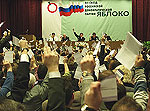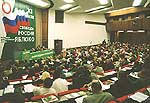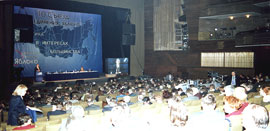Grigory Yavlinsky: Oil may drop to $ 20 per barrel
 How low oil prices may drop and how long this may last
How low oil prices may drop and how long this may last
// Complete version of Grigory Yavlinsky’s article for RBC, 16.01.2015
A significant factor behind the unfavourable economic situation in Russia is a total failure of its so-called “energy policies” for the past 15 years
A series of erroneous decisions and miscalculations of the government is explained by the inability to correctly understand and assess the key trends in the world oil market development, especially after 2009
* Aggregate growth of oil production in the world and in the US in particular;
* Emergence of a powerful market vector of slate oil extraction;
* Demand drop due to the progress in the energy saving and increase of alternative energy production (biological fuel in the first place) resulting in the dramatic change of the demand and supply balance for liquid hydrocarbons;
* Absence of adequate conception of the division of political forces around the oil market, i.e., who profits from high oil prices and who profits from low prices, the scopes and the vectors of oil smuggling and the role of the so called “Islamic State” in these flows.
This is not a complete list of blunders that led to the adoption of a series of erroneous decisions by Vladimir Putin’s and Dmitry Medvedev’s in the energy field in the recent years.
Speaking about the details of this shameful failure, we should say that one of the main reasons was that official and experts’ forecasts of a considerable part of Russian specialists and “strategists” made a mistake of including into their analysis of the prospects for oil prices all the marginal costs, that is all the expenditures on exploration and development of a new deposit.
Looks like calculations of different experts are based on this, and according to these estimates, the prime cost (marginal cost) of oil fluctuates between $ 80 to 110, and that is why “the price can not be less than 90”. This prime cost is certainly important in the long term. At the present prices, the development of new fields in the United States, Canada and many other places will really stop some day, and this will lead to a new round of price increases.
The question is when it happens.
It depends on how long it will be possible to get oil from the existing fields and how many new fields are already under development, which is less cost-effective to stop than extract it even at these or even lower prices. Again, there are different points of view, but in general, geologists agree that the peak oil production in the United States (which has increased by four times for the past ten 10 years) will fall on 2017 – 2018 and may begin declining thereafter (“traditional” oil fields may pump oil up to 20 years, but slate oil fields may have a shorter life cycle, if this is so, then the present “overproduction crisis” will last not for 15 years, as in the 1984 – 1999 biennium, but may last for ten or even seven – eight years, but certainly not a year or two).
In a short or medium term (those same 7-8 years or more) the decisive factors will be marginal cost variables, or as oil analysts call them, “cash costs” (as opposed to the “marginal costs”, although the first should be referred to as “marginal variable costs” from the point of view of economic terminology), rather than aggregate marginal costs. This is what is necessary in order to cover the costs of production and delivery of oil to the consumer from the oil deposits that have already been developed, and these are much
lower – under $ 30-40 per barrel in the US, Canada, and maybe even in China. This is the price level when production at the existing fields will be suspended.
The chart below shows that over 80 per cent of the world production is profitable at a price of around $ 30 per barrel. Basing on this estimate, we can conclude that the price will reflect marginal variable costs of $ 20 (the lower margin) to $ 50 (the upper margin) per barrel. Thus, today the markets approached what will soon be the top (not the bottom!) margin.

Source: Morgan Stanley http://www.businessinsider.com/oil-cash-costs-2014-12#ixzz3PHN4cq87
The cash costs (the prime cost) are basically what is spent on the maintenance of oil extraction, rather than what is needed to make oil extraction profitable or meet the budgetary needs of the government.
According to Myles Udland, author of the article in Business Insider (see the Source to the chart above), “As you can see on the far right, the Canadian oil sands and the US shale basins are very expensive to tap. Meanwhile in the Middle East, the Saudis, the Iraqis, and the Iranians basically stick a straw in the ground, and oil comes out” What we see happening now is an excess supply of oil, which puts pressure on oil prices, and many expected that in response OPEC would announce cuts in production. That did not happen, partially because of taking into account the experience when Arab policies of reducing oil production in 1970s did not lead to an increase in oil prices, but led to the bankruptcy of the budget of Saudi Arabia. Therefore, fight against low prices does not mean
mere reduction in production. According to oil analyst Adam Logson (see the Source to the chart above), “”Simply slowing supply growth is usually not enough to balance an oversupplied market in the short run. In commodities without a cartel, existing production must be shut-in. If true, marginal cost of investment is not the relevant metrics, it’s variable operating cost, which is closer to $35-$40/bbl on the high end.” And this was a mistake of Vladimir Putin, Igor Sechin, and almost all of our analysts, who said that the price of oil would not fall below $ 80-90 per barrel (marginal amount of investment was taken for the base instead of variables of operating costs). By the way, even our Lukoil says it like a company is satisfied with the price of oil at $ 25, and TNK once even claimed that their prime cost of oil was around $ 7.
Further dynamics of oil prices will depend on whether OPEC will be able to recover their monopoly or the world oil market will move in the direction of normal competitive conditions when prices are set by the marginal costs of production, rather than the OPEC monopoly. This is how the oil market has been functioning for nearly two decades, from 1986 to 2004. An the answer to the key question on whether the present price of about $ 50 is the lower or the upper margin of the new price range largely depends on this.
The history of oil prices, adjusted for inflation and the consumer price index in the US, shows that the price of $ 50 per barrel is a kind of “marginal” price. Indeed, the period of the past 40 years, since 1974 when OPEC has really got stronger and become influential, OPEC in 1974, can be divided into three large periods.
1) From 1974 to 1985, when the price to the benchmark crude in the US – West Texas Intermediate (WTI) fluctuated between $ 48 and $ 120 in today’s prices;
2) From 1986 to 2004, when the price fluctuated from $ 21 to $ 48 (except for two brief moments during the Russian crisis of 1998 and in 1991 when there was war in Iraq).
3) From 2005 to 2014 when oil traded again as in 1974 – 1985 at about $ 50 to $ 120, with the exception of 2008-2009, the financial crisis period.
The price range for the past ten years has been very similar to the first decade of the OPEC rule in 1974-1985, but today we have to pay special attention to 19 years from 1986 to 2004, which is a completely different period.
The difference between the two periods can be explained by the virtual collapse of OPEC in 1985, which led to the transition from a monopoly to a competitive price for the next 20 years. OPEC finally took advantage of the growth in the demand in China and regained control of the oil price and monopoly pricing in 2005.
Will the next 10-15 years become a new period of competitive pricing (when $ 50 is the upper margin), or OPEC will be able to restore its monopoly when this price will again be lower margin? According to Reuters columnist Anatole Kaletsky, (see Note above), the goal of Saudi Arabia in the recent months, is in the latter. For this purpose it needs to break the Russia – Iran alliance in oil deliveries both in terms of prices, and the scope of the market, as well as to restrict, that is, remove from the market the US slate oil producers. It should be noted, however, that even if this strategy is successfully implemented, it will not be implemented within a few months or even a year or two.
There is a more serious reasons to expect that Saudi Arabia and OPEC countries will not succeed in the next 7-10 years in restoration of their monopoly, and therefore, the price of $ 50 per barrel, corresponding to the upper margin of the variable marginal costs will be the upper margin of the new pricing ranging between $ 20 – 50:
– New technologies (for example, due to the technology of hydrofracturing and horizontal drilling, oil production in the United States has increased by over 60 per cent to 9 million barrels a day since 2010 only);
– Environmental pressure;
– Decline in the long-term demand for oil.
Strong is the pressure from environmentalists, development of the alternative and “green” energy and progress in the energy saving (for example, the new standard for automobiles and light trucks, announced by the US government, requires to bring the economic efficiency of the engine to 54.7 miles per a gallon of gasoline (23 km per liter) by 2025, while the South Korean government announced introduction of a standard of 24 km per a liter of gasoline by 2020) can generally convert a significant portion of oil extracted outside the Middle East, in the so-called “frozen resources”, as well as huge coal reserves, which remain under the ground in Europe and the US, but have lost their economic value for environmental and technological reasons.
Lifting of sanctions against Iran and the end of civil wars in Iraq and Libya will put additional pressure on the decline in oil prices in the medium term. These countries can activate such additional oil reserves and oil production which in total, along with Russia, will exceed the potential of Saudi Arabia.
Slate revolution in the United States is perhaps the strongest argument for a return to a competitive price, i.e. $ 30-40 per barrel. In spite of the fact that slate oil is relatively expensive, its production can be “on and off” much easier – and cheaper – than for ordinary oilfields. This means that slate oil production will act as the regulator, the so-called “manufacturing swing”, on the world oil markets instead of price collusions in OPEC under the leadership of Saudi Arabia.
On a truly competitive market, Saudi Arabia and other producers of inexpensive and readily available oil will always be interested in increasing production to maximum capacity, while the production of slate oil can be easily stopped when the demand is weak and rapidly increased when the demand is growing. To “really hurt” slate oil production in the United States, prices should drop below $ 40 per barrel.1 And 80 per cent of the US slate oil projects will be profitable at prices from $ 40 per barrel of WTI.
EOG Resources of Houston is one of the most efficient energy companies in the United States. Recently, it announced that the rate of profit after tax may amount to 10 per cent at some of its present oil-wells in such key slate deposits as Eagle Ford in South Texas, even if oil prices fall to $ 40 per barrel. It is also clear that companies do not want to cut drilling. It is unlikely that they will dismiss drillers who are trained to work efficiently. In addition, no one wants to be the first in cutting production, as it can play into the hands of competitors. If it is difficult to call for a joint action all 12 OPEC countries, then try to force thousands of independent operators to respond to the decline in oil prices. Also, many companies took advantage of hedging guaranteeing the best price for a part of the oil. And debt maturities in energy companies usually amount to a few years. Therefore, many companies may face problems only after 2015.2 Thus, it will be difficult to achieve reduction of production and curbing of the oil boom in the United States even at low oil prices.
All of this logics leads to the conclusion that the marginal variable costs of slate oil production in the United States, that as a rule, are estimated between $ 40 – 50, and will be the ceiling of world oil prices, rather than their lower margin for the next 7 – 10 years.
And we should specially focus on the macroeconomic impact of low oil prices. In the long term, they will be favourable for economic growth in most of developed and developing
countries, as they increase economic activity and energy demand. Fall of oil prices is good for the US economy, despite possible difficulties for some states heavily dependent on oil (Alaska, Montana and Texas, although the latter has greatly diversified its economy in the recent years, using oil revenues for this, in contrast to Russia). In general, in 2015, Americans could save $ 70 billion only due to reduction of gasoline and diesel fuel prices and thereby increase consumer spending.
Economic growth in the West increases capitalisation of giant private assets belonging to the elite of the Arab petroleum exporting countries, and in this sense the loss for the budgets of these countries from low oil prices is “compensated” be personal interest of decision-makers in Saudi Arabia and OPEC.
It is hard to say which of these arguments would be more accurate: whether prices may flow to range of $ 20 – 50 on the basis of competitive market pricing or prices may increase from $ 50 to $ 120 based on the resumption of the rule of OPEC? It will be clearer when oil prices will stay about $ 50 for at least a year.
However, it is a very long period for Russia – at least a year with the oil prices of about $ 50 at best. In this case, the current account deficit will be over 2 per cent, exports will fall to 8 per cent of GDP, the real budget deficit will be at least 5 per cent of GDP and inflation will rise by 8.6 percentage points, i.e. up to 20 per cent on an annualized basis, active spending of the Reserve Fund for covering of the deficit of 2 per cent of GDP and decline in GDP will amount to at least 6 per cent. The reserves in the absolute terms will fall by two times, as well as a percentage to GDP (from 22 to 10 per cent) and the ratio of reserves to external debt will worsen by 30 percentage points (from 67to 37 per cent)3.
A political factor may also be present in the current situation. Russia’s military-political gambling and anti-European policies could have caused informal sanctions and covert agreements. Thus, explaining the decrease in hydrocarbon prices, experts from BofA Merrill Lynch refer in their analyses to the precedents of mid 1980s – early 1990s, when cooperation of Riyadh and Washington resulted in a drop of oil prices. This led to a decline of export earnings for the USSR. Cheap oil was certainly one of the factors contributing to the political crisis and subsequent collapse of the Soviet Union4.
However, the main problem is not fall of budget revenues, but lack of domestic demand, or rather, his sharp drop.
Here is the chain of events that are simple in their logic and will take place this year leading to severe and devastating consequences for the economy.
Devaluation of the rouble – raising of tariffs by monopolies – drop of nominal and real incomes of the population – unavailability of loans – reduction of purchasing capacity of the population – considerable drop of consumption – fall of consumer demand. The budget due to a sharp decline in export revenues ceases to be the engine of the economy, a number of programmes and large projects which amounted to a few per cent of GDP will be stopped, outflow of capital will freeze investment and capital construction, prices on housing, nonresidential premises and lease will fall.
Mobilization approaches of the manual control [over the economy] and state control over businesses will lead to further increase of the costs, drop in competitiveness, lower productivity of labour, and taking into account full capacity of production facilities, unavailability of credits in the country (due to extremely high interest rates) and abroad (due to sanctions), lack of available capital for creation of new capacities and rising unemployment – all this will lead to a severe recession and tangible double-digit inflation already in the first half of 2015.
Given that the government neither enjoy credibility from the business nor have a strategy for overcoming the crisis (we always here words only that are not connected with reality), the authorities do not have a reputational resource which so much needed in the present situation. However, there are shocking information chatter boxes and, to put it mildly, strange figures such as Sergei Glazyev. It is not just bad, all this leads to an increase in the so-called “rational expectations” of inflation and it will be almost impossible to reverse this trend.
Conclusions
1. Oil prices are likely to be at the level of $ 20 – 40 in the next 5-7 years. This is mainly the result of objective economic developments in the world markets and an energy breakthrough in the United States. A political factor is probably present in this price reduction: break of relations and confrontation between Russia and the United States, as well as the anti-Syrian oil Arab countries, which might have led to a rapid fall of oil prices in connection with the task to push Russia (and Iran) away from the oil markets by means of undercover arrangements and informal sanctions.
2. Even a quick analysis shows that all the developments (except for the sanctions) have been evident for at least past five or six years. Unpreparedness for such a development is a consequence of an extremely incompetent management, poor quality of analytical work, unprecedented amateurish level of discussion of technological and economic aspects of the modern international and the Russian energy policies in the Government. Suffice it to say that in autumn 2014, the budget was adopted on the basis the estimates that oil price would be at $ 97 per barrel.
3. Low oil prices coupled with economic sanctions and taking into account serious fundamental economic problems of the Russian economy suggests that 2015 will see further devaluation of the rouble against the dollar, decline in production, inflation and, as a consequence, growth of social tensions.
Russia’s ongoing military-political gambling in Ukraine in 2014, absurd anti-European policies and incompetent management make a way out of this situation virtually impossible.
For Russia, taking into account its economic problems, this can lead to an economic disaster.
____________________
1 The Wall Street Journal; 07.11.2014
2 The Wall Street Journal; 31.10.2014; Рассел Голд, Эрин Эйлворт, Бенуа Фокон
3 Sources: Morgan Stanley, Bloomberg 4 Александр Абрамович “Москва пытается договориться с ОПЕК о прекращении падения цен на нефть”, “Биржевой лидер” (Alexander Abramovich “Moscow is trying to negotiate with OPEC that drop of oil prices should be stopped”. Birzhevoi Lider.)
Posted: January 22nd, 2015 under Economy.






